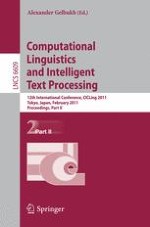This two-volume set, consisting of LNCS 6608 and LNCS 6609, constitutes the thoroughly refereed proceedings of the 12th International Conference on Computer Linguistics and Intelligent Processing, held in Tokyo, Japan, in February 2011. The 74 full papers, presented together with 4 invited papers, were carefully reviewed and selected from 298 submissions. The contents have been ordered according to the following topical sections: lexical resources; syntax and parsing; part-of-speech tagging and morphology; word sense disambiguation; semantics and discourse; opinion mining and sentiment detection; text generation; machine translation and multilingualism; information extraction and information retrieval; text categorization and classification; summarization and recognizing textual entailment; authoring aid, error correction, and style analysis; and speech recognition and generation.
